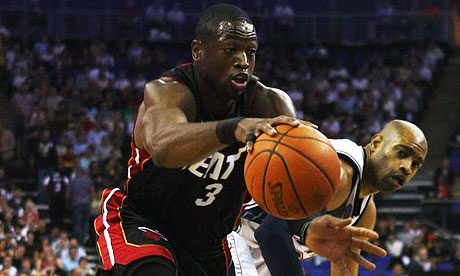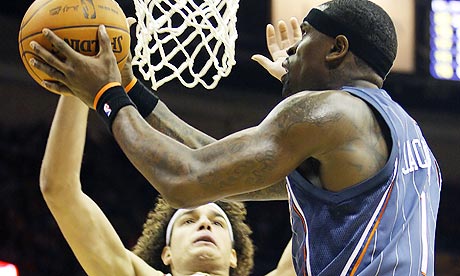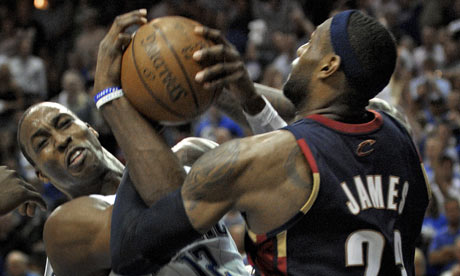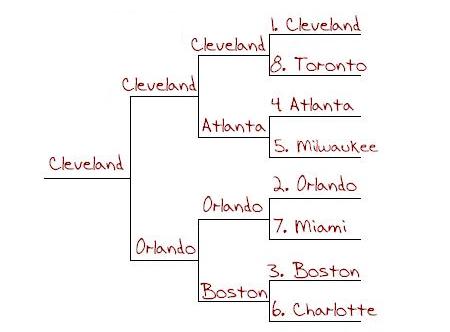Cleveland Bracketology: A Look at the Road to the Finals.
2010-03-20Thanks to the blend of March Madness and June weather, lately I’ve been thinking about Cleveland’s journey through the east this postseason. Anxious for the playoffs to begin, only a dozen games remain before the Cavaliers begin one of the most anticipated postseasons in franchise history. But who are the biggest threats to this dangerous Cavs team that already clinched another Central Division title and hold a six game cushion as the big dogs of the east?
Well, in the spirit of March Madness, I decided to break down the eastern conference playoff teams and their threat level as it pertains to the Cleveland Cavaliers.
The Cinderella’s.

Dwyane Wade, who once led a Cinderella Marquette team to the Final Four, needs a lot of help before making the NBA's final four with this Heat team.
Toronto (currently the 8th seed)
Toronto is one of those teams that could give the Cavaliers a run for their money based on some matchup issues. The key for Cleveland is to attack Toronto’s porous transition defense, which ranks 27th in the league allowing 17.4 fastbreak points per game. Cleveland, known for favoring a slower halfcourt tempo, is 17th in the league in fastbreak offense, averaging 13.9 points per game. In their only loss against Toronto, the Cavaliers were outscored in fastbreak points 12 to 9. However, in their two wins combined, the Cavs averaged 27.5 fastbreak points per game compared to just 16.0 points per game from Toronto (+11.5 points per game and +13.6 more than their average).
While the Raptors have played the Cavaliers tight this season, winning the first matchup by 10 points and losing the other two games by 8 points each, they don’t present that great of a threat. The Cavaliers are notorious for starting out the year slow, opening up the past three seasons 1-2, explaining the early loss in Toronto. Also, Mike Brown experimenting with his twin tower lineup of Shaquille O’Neal and Zydrunas Ilgauskas against very good jumpshooters in Chris Bosh and Andrea Bargnani didn’t help out much either. In the end, with the Raptors dropping 10 of their last 12 games, they may lose their playoff spot to a bubble team like the Chicago Bulls.
Miami (currently the 7th seed)
Miami was always one of those teams that you just didn’t want to see the Cavaliers play in critical moments of the season. With great duels between LeBron James and Dwyane Wade, Miami was 10-5 against Cleveland in the first four seasons of those superstars. Now, only the great duels remain, as the Cavaliers have won 9 out of the last 10 matchups dating back to the start of the 2007-08 season. Simply put, the Heat are not a threat. Even if you go beyond the fact that LeBron’s supporting cast is light years ahead of Wade’s, Miami has no one to watch James, who has averaged 31.6 points per game in 18 games against the Heat since the 2005-06 season.
If the Cavaliers were to meet the Heat, Dwyane Wade could easily average 33-35 points per game. But, I’d also be willing to bet that Cleveland’s margin of victory would be at least 10 points per game. The biggest threat in this potential matchup would be the lure of those South Beach weekends.
Milwaukee (currently the 5th seed)
The Young Bucks in Milwaukee, led by Brandon Jennings and Andrew Bogut, have surprised quite a few people this year. They’ve overcome some injuries and Scott Skiles has turned them into a top 10 NBA defensive team. But should this revitalization in Bucks land trouble Cavaliers fans? I wouldn’t go that far. Going 1-2 against the Cavs so far this season, this is the same Bucks team that allowed Cleveland to go on a 29-0 run… in Milwaukee. Their sole win against the Cavaliers was a 7 point victory in which the road team suited up without LeBron James, Shaquille O’Neal, and Zydrunas Ilgauskas. For some perspective, in the two wins against Milwaukee, those three players combined for 36.5 points, 16.5 rebounds, and 10.5 assists per game.
Granted, the Cavaliers could be without Shaquille O’Neal for most of the series should they meet Milwaukee in the early rounds, but Ilgauskas will certainly be back in action. The key is having a true center to slow down Andrew Bogut. In Milwaukee’s win against the centerless Cavaliers, Bogut scored 15 points on 55.6% shooting. On the other hand, in the two games that featured Z, Shaq, and Bucks losses, Bogut averaged only 5.5 points on 27.8% shooting. Ultimately, the youth of the Bucks should prove no match for the experience of the Cavaliers, who have never lost to a playoff team seeded worse than 3rd in the LeBron James era. I think that makes almost all of the Cinderella teams non-threats.
The Mid-Majors.

Stephen Jackson averaged 22.7 points per game in three games versus the Cavaliers this season, winning all three of those matchups with the Bobcats.
Charlotte (currently the 6th seed)
Now Charlotte is 2.5 games behind the Milwaukee Bucks, yet they’re considered a mid-major? Against the Cavaliers they certainly are. One of only two teams to win the season series against the Cavaliers (the Nuggets being the other one) and the only team to beat Cleveland three times this season, the Charlotte Bobcats match up extremely well against the Cavs. But how are the Bobcats managing to pick apart the best team in the NBA?
Well, not only does Larry Brown have the Bobcats playing inspired defense, but they’re also winning the battle of easy buckets. In the first game of the season series in Cleveland, Charlotte was outscored in points in the paint 32-24 and shot only 42.6% from the floor compared to Cleveland’s 58.1% field goal percentage. In the three games following that loss, Charlotte out scored Cleveland in the paint 130-106 and shot 50.5% from the field, compared to just 44.0% shooting by the Cavaliers. Considering the Cavaliers are number one in opponent’s points in the paint allowed (36.0) and second overall in opponent’s field goal percentage (43.8%), I’d say allowing the Bobcats to average 43.3 points in the paint per game on 50.5% shooting in three straight games is an issue of focus and desire.
Charlotte is one of those teams that I convince myself is not a threat because the Cavaliers can turn it on whenever they want to beat them. But as hard as I try, I don’t completely buy it. While I think the Bobcats would take only 2 games in a 7 game series versus the Cavaliers, they’re still a viable threat. And don’t forget that new addition Stephen Jackson was a huge part of the Golden State team that knocked off #1 Dallas back in 2007. This team can be scary.
Atlanta (currently the 4th seed)
Tied with the Boston Celtics for the third best record in the east, the Atlanta Hawks are more major than mid-major. But it’s hard to favor a Hawks team that is 5-23 against the Cavaliers during the LeBron James era, having lost eight straight games against Cleveland including a second round sweep last postseason. While this Hawks squad is certainly different than past teams, it’s hard to picture them as a legitimate threat given the back to back collapses against Cleveland this season, the four double digit losses in the playoffs last season, and the fact that they haven’t won in Cleveland since November of 2006.
On area of concern, however, should be the addition of Jamal Crawford. In the two games against Cleveland this season, Crawford averaged 18.5 points and 4.5 rebounds and shot 5-7 (71.4%) from three. Crawford, a notorious Cavs killer originally drafted by Cleveland, has averaged 21.1 points per game against the Cavaliers in his last 18 games dating back to the start of the 2003-04 season, making at least one three-pointer in all 18 games (2.3 3pm per game).
With this new cast I could see the Cavaliers struggling with the Hawks, should they meet in the playoffs. Then again, it’s hard for Atlanta to put up less of a fight than they did last postseason. Regardless, I still believe that the Hawks aren’t as big of a threat as a team like the Bobcats, which match up fairly well against Cleveland. While I feel the Cavaliers have bigger threats, Jamal Crawford could make the Hawks a tough team to square off against in the playoffs.
The Top Seeds.

Once reliant upon LeBron James and countless others to help defend Dwight Howard, the Cavs will need Shaquille O'Neal to make good on his "no more double teams" offseason promise in the Eastern Conference Finals.
Boston (currently the 3rd seed)
One of the two most recent teams to knock the Cavaliers out of the playoffs, the Boston Celtics have seemingly gotten the best of Cleveland since the arrival of Kevin Garnett and Ray Allen in 2007. That is, up until now. From that 2007-08 season to last season the Cavs and Celtics squared off 15 times, including 7 postseason games, in one of the most stubborn duels you’ll ever witness. On all 15 occasions the home team came away with the victory, giving the number one seed Boston Celtics the edge in game 7 of the 2008 playoffs.
This season, however, gave way to those past trends. The Boston Celtics opened up the season strong, winning their first game in Cleveland and holding onto the eastern conference number one seed for quite some time. But the Cavaliers eventually rebounded, winning in Boston by 20 points, at home by 11 points, all while distancing themselves from the rest of the pack as the leaders of the east.
In the meanwhile, the Celtics have been trying to find their identity and return to that defensive prowess that netted them a championship two seasons ago. In that 2007-08 season, Boston’s defense allowed only 90.3 points per game on 41.9% shooting. Against the Cavaliers that year they allowed 95.0 points per game on 42.5% shooting. Last season, the Celtics allowed 93.4 points per game on 43.1% in the regular season and 96.0 points per game on 48.5% against Cleveland. And so far this season, those averages have continued to worsen, with Boston allowing 94.3 points per game on 44.7% shooting. Furthermore, those numbers have become unjustifiable against the Cavaliers, who have averaged 100.3 points per game on 45.1% shooting through 3 games.
The Celtics have many problems to juggle, from an aging trio and injuries to new role players and inconsistent play. However, their biggest concern is the collapse of their defense, especially in regards to the Cavaliers, who have averaged 106.0 points per game their last two meetings with the Celtics, including a 108-88 trouncing in Boston. With all of these issues and a large question mark next to the health of the team come May, I have a hard time believing that Boston is as big of a concern as they were two years ago.
Orlando (currently the 2nd seed)
From Boston to the other team responsible for one of Cleveland’s last two playoff exits, Orlando still presents the largest threat to the Cavaliers in the eastern conference. Fans all remembered what happened last year (if you know how to forget that series, please email me the trick). After the most successful season in Cavaliers history, the postseason ended abruptly, when Cleveland failed to defeat the Orlando Magic, a team that was a matchup nightmare.
But how do they look against the Magic this year? Well, first off, instead of being 1-2 against the Magic as they were last season, the Cavaliers are 2-1 so far this season, winning their first game in Orlando since February 2008 after going 0-6 in between that time frame. And while last season saw the Cavaliers completely embarrass themselves in Orlando, losing both regular season games by a combined 40 points (-20 points per game), this season they were +3 in their season split in Orlando (+1.5 points per game). Furthermore, the Cavs were able to flip the script in regard to three-point shooting this season. In the playoffs, the Orlando Magic shot 62-152 (40.8%) from three compared to just 42-130 (32.3%) from the Cavaliers. So far this season the Cavaliers are 22-50 (44.0%) from three-point range, while limiting the Magic to 22-64 (34.4%) from deep. Just to reiterate, last postseason the Magic made 20 more threes than the Cavs (+3.3 per game) and shot 8.5% better from beyond the arc. In three games this season, the two teams have made an equal number of three-pointers and the Cavs are shooting 9.6% better from three.
But limiting the Magic to a human three-point percentage is just one of the ways in which the Cavaliers have improved against Orlando from last season to this season. The other would be their defense on Dwight Howard. In the conference finals Howard averaged 25.8 points per game on 54-83 (65.1%) shooting. Thanks to the assistance of Shaquille O’Neal, Howard has averaged only 17.3 points per game on 16-27 (59.3%) shooting in the three games this season. O’Neal has also forced the Magic center to defend as well, averaging 13.3 points per game on 18-27 (66.7%) shooting, leading to an average of 4.7 fouls per game for Howard.
The Magic still present some matchup problems for the Cavaliers, but not nearly to the degree as last season. The Cavs have also implemented some new pieces as well, such as a more-than-capable scorer at the power forward position in Antawn Jamison, who will make Rashard Lewis defend unlike either Ben Wallace or Anderson Varejao could last postseason. Should the Cavaliers and Magic meet once again in the eastern conference finals, which everyone is expecting, it will make for yet another great series. In the end, however, with a healthy Shaquille O’Neal and several new pieces in place to limit the Magic’s three-point shooters and big men, the Cavaliers should be more than ready for redemption.
Make sure to join the discussion at Numbers Don’t and Real Cavs Fans!


Haha, I don’t mind taking second in that category behind LeBron. In fact, that’s a pretty good second place medal.
BTW, good write up Cam. When CTB and Numbers Don’t combine forces, it’s about as close to Chuck Norris Awesome as I’ve ever personally witnessed. Alright I’m exaggerating a bit, LeBron holds that record of course. But you’re close, I swear. Seriously, good stuff…
Kevin, I don’t believe we own any picks in the 2010 draft. Our first rounder goes to Washington for Jamison and our second rounder goes to Phoenix for Shaq. I suppose theoretically we could trade or purchase a pick, like we did last year. However, that tends to run a team upwards of $2MM-$3MM, plus the player’s actual salary cost. The Cavs would also have to drop yet another body off our 15 man roster, above and beyond the impending release of D Jackson this week. That means the team would have to part ways with a young talent like… Read more »
espn says Omar Samhan will go late 2nd round to undrafted. I’ll admit i didnt know who this guy was before a few days ago, but since i watched them play Richmond I’ve been praying that the cavs get him in the 2nd round. I could guarantee he’d be a better pick than christian eyenga
Lebron makes his first three shots, culminating in a 3, and then doesn’t take a shot for the rest of the quarter. Is this real life?
It’s funny what the trauma of last season’s playoff exit has done to us. We have LeBron, Shaq, Tawn, Andy, and Mo if he shows up, and here we are worried about people like Andrew Bogut and teams like the Bucks and Bobcats of all teams? lol (ok, Bobcats concern is legit).
What’s funny is I posted about Samhan over at nba.com/cavs, and suddenly every cavs fan is worried about him lacking footspeed. Right, as if the guy we’ve had at center for the last 10 years whom everyone loves has had any sort of footspeed whatsoever, but now it’s important.
I say the Bucks are far more dangerous than the Bobcats at this point. Out of the two teams, Bogut is by far the best player and quite frankly a guy I don’t want t odeal with. Bring on Boston, plz.
Thanks for the comments guys…
@Dylan, Definitely agree with the Bobcats having a great shot to knock off the Celtics should they be paired up.
I totally agree Ray. When it comes to post players, people are so awed by athleticism w/o ever checking whether or not the guy can play. I look at Derrick Favors for instance. Now, maybe the guy will be great….but people are projecting his top 5 status based solely on athletic ability alone and not production. Samhan is one of the more polished big men I’ve seen in some time. His footwork is very, very, very good. I don’t know if I can say that enough…very very very good. Some of the best footwork I’ve seen for a bigman. And,… Read more »
Rich- Samhan looked awesome. Him not going in the 1st round would be pretty bad. He’s very, very skilled. Too many guys get drafted on athleticism but they can’t play. He can play.
Lets just hope we don’t end up like Kansas.
Dylan, I’m not too concerned with Vince Carter because:
1. He’s Vince Carter, and
2. The Cavs best one-on-one defenders are at the 2 and 3. Vince will have difficulty all through the series, the same way Kobe had difficulty with the Cavs this season. And Vince is no Kobe (see number 1)
If the Cavs can get out of their current funk in time and play defense for entire games at a time, then they will beat the Magic I think. If not then the Magic can put up a lot of threes during those lapses.
Speaking of the tourney, is Omar Samhan not the best true center you’ve seen this year? Out of all the big men, most are going to be Power Fowards in the pros (like Cousins or Patterson)…this guy is a legit center and is easily the best one I’ve seen. Kid is super skilled for a college 7 footer, Never usually see that, and tbh I think he’s better than Aldrich or Ed Davis, the two centers who are projected to be lottery picks.
I agree with Dylan. Vince Carter has been playing a lot better recently, and frankly, I’m worried. Carter and Matt Barnes are legitmate threats from outside and inside. The team is gelling now and they are staying healthy. I think we’ll need 35 points from lebron every night to win. Not saying he can’t do that.
Vince Carter will also be a huge factor. If the Cavs can shut down the lane and force him to chuck up 3’s, which he has no problem doing, it will be a good outcome…
I think Dwight Howard’s FT% will be a big factor when they meet CLE in this post-season. This has been his best season from the line since his rookie year, but he’s still inconsistent; & w/ the return of our twin towers, we’ll be able to defend him better anyway. & if Mo, AP, & Gibson bring their A-game, we’ll be able to match up better from behind the arc as well. Even with the Cavs’ improvements, ORL is still the squad that worries me the most, far more than CHA & even LA. But unless the Magic throw away… Read more »
Great article, and I agree the Magic will be the only real problem. The Cavs have done a good job filling the holes they had last year, now it comes down to their perimeter defense. If their defense succeeds so will the offense.
I see the Bobcats beating the Celtics in the first round..